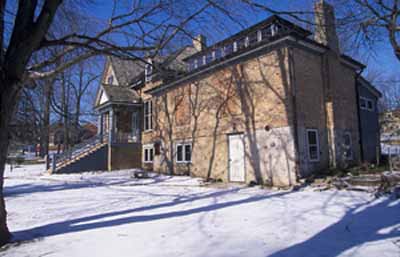Homer Watson House National Historic Site of Canada
Kitchener, Ontario

Exterior view
© Parks Canada Agency / Agence Parcs Canada, J. Butterill, 1995.
Address :
1754 Old Mill Road, Kitchener, Ontario
Recognition Statute:
Historic Sites and Monuments Act (R.S.C., 1985, c. H-4)
Designation Date:
1981-01-15
Dates:
-
1834 to 1834
(Construction)
-
1881 to 1936
(Significant)
-
1893 to 1893
(Significant)
-
1906 to 1906
(Significant)
Event, Person, Organization:
-
Homer Watson
(Person)
-
Doon School of Fine Arts
(Organization)
-
Adam Ferrie
(Builder)
Other Name(s):
-
Homer Watson House
(Designation Name)
-
Homer Watson House and Gallery
(Other Name)
-
Doon School of Fine Arts
(Other Name)
Research Report Number:
1980-031(P), 1980-032(P)
Description of Historic Place
Homer Watson House National Historic Site of Canada is located in the hamlet of Doon, which is now part of Kitchener, Ontario. This modest, 19th-century, one-and-a-half-storey house that sits within a generous property, was the home and studio of Canadian landscape artist Homer Watson. The house was designated for its dramatic gallery and studio addition that contains works of art and creative spaces associated with Watson’s career. The designation refers to the original house with its Watson-era additions on its legal property as of 1980.
Heritage Value
Homer Watson House was designated a national historic site of Canada in 1980 because of: its association with the artist Homer Watson.
Canadian landscape painter Homer Watson (1856-1936), born in Doon, was commemorated by the National Historic Sites and Monuments Board of Canada as a person of national historic importance in 1939. He purchased this house when he married in 1881, and lived in it until he died in 1936. Although the house is a typical 19th-century brick farmhouse built in 1834, Watson personalized its facilities to pursue his art, and made two additions: a studio addition on the rear of the house (1893) and a gallery (1906). Particular value lies in those rooms and places associated with his art, his studio and gallery spaces, viewscapes and features of the surrounding site associated with his paintings, and location of the residence within the historic community of Doon. Some of Watson’s most respected works are views of the surrounding countryside from various vantage points of the property. The house later became the Doon School of Fine Arts and a privately maintained memorial to Watson. Since that time it has been operated by the City of Kitchener.
Source: Historic Sites and Monuments Board of Canada, Minutes, June 1980.
Character-Defining Elements
Key features contributing to the heritage value of this site include: the location of the residence in the historic community of Doon; the site of the residence within a generous property with its surviving landscape elements from Watson’s time including the size, allocation and nature of particular plantings and elements; its irregular massing, including two additions; the contrast between the conventional house with its L-shaped footprint, front-facing gable and bay window and the blocky Watson additions, one lit by a roof monitor; the studio addition built on to the back of the house, which features the frieze by Watson himself; the gallery addition, well-designed for its purpose, with clerestory windows and a monitor, which allow for soft, indirect light; surviving interior furnishings, materials, layout, and detailing of the residence and gallery from Watson’s time; the integrity of artistic work by Watson incorporated into the fabric of the residence, and in particular the studio frieze; continued association of specific examples of Watson’s work with his home, including paintings and sketches; surviving Watson-era patterns of circulation, access and egress; viewscapes from particular windows within the residence and places on the surrounding landscape as expressed in Watson’s paintings.